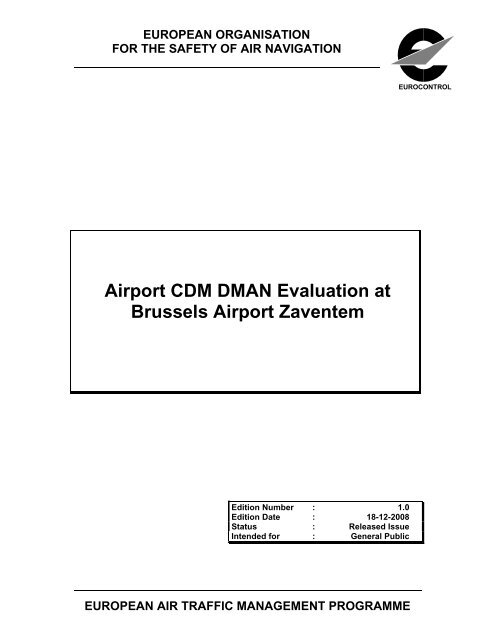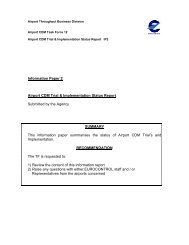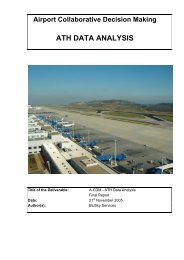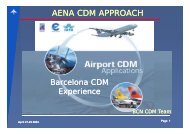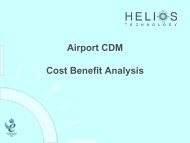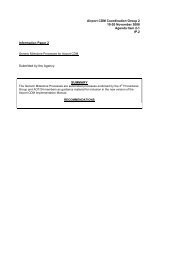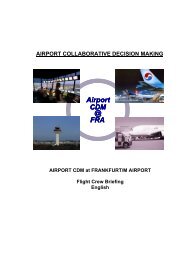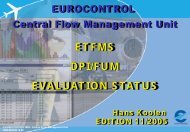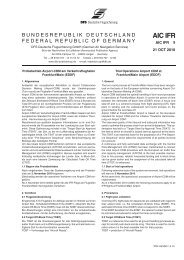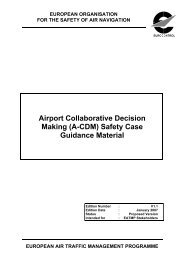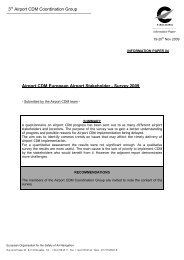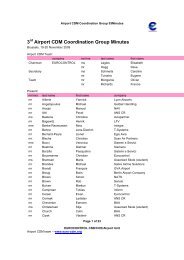Airport CDM DMAN Evaluation at Brussels Airport Zaventem
Airport CDM DMAN Evaluation at Brussels Airport Zaventem
Airport CDM DMAN Evaluation at Brussels Airport Zaventem
You also want an ePaper? Increase the reach of your titles
YUMPU automatically turns print PDFs into web optimized ePapers that Google loves.
EUROPEAN ORGANISATION<br />
FOR THE SAFETY OF AIR NAVIGATION<br />
<strong>Airport</strong> <strong>CDM</strong> <strong>DMAN</strong> <strong>Evalu<strong>at</strong>ion</strong> <strong>at</strong><br />
<strong>Brussels</strong> <strong>Airport</strong> <strong>Zaventem</strong><br />
Edition Number : 1.0<br />
Edition D<strong>at</strong>e : 18-12-2008<br />
St<strong>at</strong>us : Released Issue<br />
Intended for : General Public<br />
EUROPEAN AIR TRAFFIC MANAGEMENT PROGRAMME<br />
EUROCONTROL
TBD<br />
<strong>Airport</strong> <strong>CDM</strong> <strong>DMAN</strong> <strong>Evalu<strong>at</strong>ion</strong> <strong>at</strong> <strong>Brussels</strong> <strong>Airport</strong> <strong>Zaventem</strong><br />
DOCUMENT CHARACTERISTICS<br />
TITLE<br />
<strong>Airport</strong> <strong>CDM</strong> <strong>DMAN</strong> <strong>Evalu<strong>at</strong>ion</strong> <strong>at</strong> <strong>Brussels</strong> <strong>Airport</strong><br />
<strong>Zaventem</strong><br />
EATMP Infocentre Reference:<br />
Document Identifier Edition Number: 1.0<br />
Abstract<br />
Keywords<br />
Edition D<strong>at</strong>e: 18-12-2008<br />
Contact Person(s) Tel Unit<br />
Volker Huck 93151 DAS/ATS<br />
Elisabeth Lagios 93390 DAP/AOE<br />
STATUS, AUDIENCE AND ACCESSIBILITY<br />
St<strong>at</strong>us Intended for Accessible via<br />
Working Draft General Public Intranet <br />
Draft EATMP Stakeholders Extranet <br />
Proposed Issue Restricted Audience Internet (www.eurocontrol.int) <br />
Released Issue Printed & electronic copies of the document can be obtained from<br />
the EATMP Infocentre (see page iii)<br />
P<strong>at</strong>h:<br />
ELECTRONIC SOURCE<br />
\\HHBRUNA05\etuinstr$\AIRPORT C D M\<strong>DMAN</strong>\AIRPORTS D M A N\<strong>Brussels</strong><br />
Host System Software Size<br />
Windows_NT Microsoft Word 10.0 486 Kb<br />
Page ii Released Issue Edition Number: 1.0
<strong>Airport</strong> <strong>CDM</strong> <strong>DMAN</strong> <strong>Evalu<strong>at</strong>ion</strong> <strong>at</strong> <strong>Brussels</strong> <strong>Airport</strong> <strong>Zaventem</strong><br />
EATMP Infocentre<br />
EUROCONTROL Headquarters<br />
96 Rue de la Fusée<br />
B-1130 BRUSSELS<br />
Tel: +32 (0)2 729 51 51<br />
Fax: +32 (0)2 729 99 84<br />
E-mail: e<strong>at</strong>mp.infocentre@eurocontrol.int<br />
Open on 08:00 - 15:00 UTC from Monday to Thursday, incl.<br />
DOCUMENT APPROVAL<br />
The following table identifies all management authorities who have successively approved<br />
the present issue of this document.<br />
AUTHORITY NAME AND SIGNATURE DATE<br />
Please make sure th<strong>at</strong> the EATMP Infocentre Reference is present on page ii.<br />
Edition Number: 1.0 Released Issue Page iii
<strong>Airport</strong> <strong>CDM</strong> <strong>DMAN</strong> <strong>Evalu<strong>at</strong>ion</strong> <strong>at</strong> <strong>Brussels</strong> <strong>Airport</strong> <strong>Zaventem</strong><br />
DOCUMENT CHANGE RECORD<br />
The following table records the complete history of the successive editions of the present<br />
document.<br />
EDITION<br />
NUMBER<br />
001<br />
002<br />
003<br />
004<br />
005-06<br />
007<br />
1.0<br />
EDITION<br />
DATE<br />
06-06-<br />
2007<br />
22-06-<br />
2007<br />
30-05-<br />
2008<br />
3-11-<br />
2008<br />
27-11-<br />
10-12-<br />
2008<br />
16-12-<br />
2008<br />
18-12-<br />
2008<br />
INFOCENTRE<br />
REFERENCE<br />
REASON FOR CHANGE<br />
PAGES<br />
AFFECTED<br />
Initi<strong>at</strong>e document All<br />
Restructure, add new ATCO feedback All<br />
Quantit<strong>at</strong>ive results added All<br />
Internal AOE & ATS adapt<strong>at</strong>ions All<br />
Internal & initial DLR comments All<br />
Internal comments All<br />
Final Version none<br />
Page iv Released Issue Edition Number: 1.0
<strong>Airport</strong> <strong>CDM</strong> <strong>DMAN</strong> <strong>Evalu<strong>at</strong>ion</strong> <strong>at</strong> <strong>Brussels</strong> <strong>Airport</strong> <strong>Zaventem</strong><br />
CONTENTS<br />
DOCUMENT CHARACTERISTICS ............................................................................. ii<br />
DOCUMENT APPROVAL ........................................................................................... iii<br />
DOCUMENT CHANGE RECORD .............................................................................. iv<br />
EXECUTIVE SUMMARY .............................................................................................. 1<br />
1.1 Document ............................................................................................................................... 3<br />
1.2 Audience ................................................................................................................................ 3<br />
1.3 Purpose .................................................................................................................................. 3<br />
1.4 Background ............................................................................................................................ 3<br />
1.5 Justific<strong>at</strong>ion ............................................................................................................................. 4<br />
1.6 References ............................................................................................................................. 4<br />
2. PROBLEM, CONCEPT, BENEFITS, SCOPE & OBJECTIVES ........................... 6<br />
2.1 Today’s Traffic Bottlenecks ..................................................................................................... 6<br />
2.2 High Level Concept ................................................................................................................ 7<br />
2.3 Expected benefits ................................................................................................................... 7<br />
2.4 <strong>DMAN</strong> Concept <strong>at</strong> <strong>Brussels</strong> <strong>Airport</strong> ......................................................................................... 8<br />
2.5 Scope of Experiment .............................................................................................................. 8<br />
2.6 Objectives ............................................................................................................................... 8<br />
2.7 Methodology ........................................................................................................................... 8<br />
3. The <strong>Brussels</strong> ATC TWR Environment ................................................................ 9<br />
3.1 Advanced Movement System and Runway Sequencing ......................................................... 9<br />
3.2 Tower Procedures & Collabor<strong>at</strong>ive Decision Making .............................................................. 9<br />
3.2.1 Clearance Delivery .......................................................................................................... 9<br />
3.2.2 Ground Control ............................................................................................................. 10<br />
3.2.3 Runway Control ............................................................................................................. 11<br />
4. The Eurocontrol / DLR <strong>DMAN</strong> ........................................................................... 12<br />
4.1 Purpose & Functionality of the EUROCONTROL / DLR <strong>DMAN</strong> ............................................ 12<br />
4.2 Install<strong>at</strong>ion <strong>at</strong> the <strong>Brussels</strong> <strong>Airport</strong> <strong>CDM</strong> Environment .......................................................... 12<br />
5. Qualit<strong>at</strong>ive Results ............................................................................................. 13<br />
5.1 Feedback on EUROCONTROL / DLR <strong>DMAN</strong> ....................................................................... 13<br />
Edition Number: 1.0 Released Issue Page v
<strong>Airport</strong> <strong>CDM</strong> <strong>DMAN</strong> <strong>Evalu<strong>at</strong>ion</strong> <strong>at</strong> <strong>Brussels</strong> <strong>Airport</strong> <strong>Zaventem</strong><br />
5.1.1 Prediction ...................................................................................................................... 13<br />
5.1.2 Separ<strong>at</strong>ion ..................................................................................................................... 13<br />
5.1.3 HMI ............................................................................................................................... 13<br />
6. Quantit<strong>at</strong>ive Results .......................................................................................... 14<br />
6.1 Normal Oper<strong>at</strong>ions................................................................................................................ 14<br />
6.1.1 The Traffic Situ<strong>at</strong>ion ...................................................................................................... 15<br />
6.1.2 <strong>DMAN</strong> TTOT versus ATOT ........................................................................................... 16<br />
6.1.3 <strong>DMAN</strong> TTOT-Error <strong>at</strong> given clearances (SU, PB, TAXI) ................................................ 17<br />
6.1.4 <strong>DMAN</strong> TSAT versus AOBT ........................................................................................... 19<br />
6.2 Adverse Conditions ............................................................................................................... 19<br />
7. ACHIEVEMENTS, Observ<strong>at</strong>ions, Conclusions & Recommend<strong>at</strong>ions .......... 22<br />
7.1 General Achievement ........................................................................................................... 22<br />
7.1.1 Technical Observ<strong>at</strong>ions ................................................................................................. 22<br />
While the tool proved to be accur<strong>at</strong>e and robust enough to function properly over<br />
recorded traffic files in research environment, the connection to a real ATC Flight<br />
D<strong>at</strong>a Processing system (the Belgocontrol AMS), called for the development of<br />
dedic<strong>at</strong>ed interface whose role was two-fold: ................................................................ 22<br />
7.1.2 Oper<strong>at</strong>ional Observ<strong>at</strong>ions .............................................................................................. 23<br />
7.2 Conclusions .......................................................................................................................... 24<br />
7.2.1 TTOT ............................................................................................................................ 24<br />
7.2.2 TSAT ............................................................................................................................. 24<br />
7.2.3 Adverse Conditions ....................................................................................................... 24<br />
7.3 Recommend<strong>at</strong>ions ................................................................................................................ 24<br />
7.3.1 <strong>Airport</strong> <strong>CDM</strong> Oper<strong>at</strong>ion .................................................................................................. 24<br />
7.3.2 <strong>DMAN</strong> Oper<strong>at</strong>ion ........................................................................................................... 25<br />
7.3.3 Controller HMIs ............................................................................................................. 25<br />
7.3.4 Further <strong>DMAN</strong> surveys .................................................................................................. 25<br />
Page vi Released Issue Edition Number: 1.0
<strong>Airport</strong> <strong>CDM</strong> <strong>DMAN</strong> <strong>Evalu<strong>at</strong>ion</strong> <strong>at</strong> <strong>Brussels</strong> <strong>Airport</strong> <strong>Zaventem</strong><br />
Edition Number: 1.0 Released Issue Page vii
<strong>Airport</strong> <strong>CDM</strong> <strong>DMAN</strong> <strong>Evalu<strong>at</strong>ion</strong> <strong>at</strong> <strong>Brussels</strong> <strong>Airport</strong> <strong>Zaventem</strong><br />
EXECUTIVE SUMMARY<br />
The main purpose of the conducted shadow mode trials was to achieve both qualit<strong>at</strong>ive and<br />
quantit<strong>at</strong>ive results and receive feedback on the functionality of EUROCONTROL/DLR<br />
<strong>DMAN</strong> in a <strong>CDM</strong> environment oper<strong>at</strong>ing <strong>at</strong> <strong>Brussels</strong> <strong>Airport</strong> <strong>Zaventem</strong>, as well as to define<br />
oper<strong>at</strong>ional requirements within the frame of <strong>Airport</strong> <strong>CDM</strong> concept elements. This report<br />
describes the evalu<strong>at</strong>ion of the trials in collabor<strong>at</strong>ion with Belgocontrol air traffic controllers <strong>at</strong><br />
<strong>Brussels</strong> <strong>Airport</strong> <strong>Zaventem</strong>. The trials were conducted in June 2007 and April 2008, for<br />
periods of three days for each trial.<br />
A common result of many <strong>DMAN</strong> simul<strong>at</strong>ions and studies in the past was th<strong>at</strong> more accur<strong>at</strong>e<br />
traffic planning replacing today’s first-come-first-served principle could lead to large benefits<br />
for stakeholders in terms of capacity, environment, efficiency and safety. These expect<strong>at</strong>ions<br />
have led the industry to develop planning tools like <strong>DMAN</strong>, AMAN etc.<br />
Based on these expected benefits and industry developments a <strong>DMAN</strong> demonstr<strong>at</strong>or, the<br />
EUROCONTROL/DLR <strong>DMAN</strong>, has been developed by EUROCONTROL in cooper<strong>at</strong>ion with<br />
DLR in 2003. It is adaptable to any airport and can be used for simul<strong>at</strong>ion and live trials. It<br />
helps EUROCONTROL member st<strong>at</strong>es to implement <strong>DMAN</strong> functionality from 2006<br />
onwards. The <strong>DMAN</strong> demonstr<strong>at</strong>or permits technical and oper<strong>at</strong>ional staff to become familiar<br />
with the concept. It supports ANSPs in the production of<br />
- tailored cost/benefit reports,<br />
- airport specific concepts of use,<br />
- oper<strong>at</strong>ional requirements - procurement specific<strong>at</strong>ions.<br />
Industry can profit from the tool by using it as reference pl<strong>at</strong>form.<br />
In parallel to the mentioned European research projects, the <strong>Airport</strong> <strong>CDM</strong> implement<strong>at</strong>ion<br />
project in EUROCONTROL has been developed from 2000 onwards, with the aim to<br />
enhance oper<strong>at</strong>ional efficiency by improving event predictability (reference 11). Years of<br />
concept enhancements and oper<strong>at</strong>ional experiences during implement<strong>at</strong>ions <strong>at</strong> airports<br />
resulted in expected benefits similar to those mentioned above. In 2006 the synergy between<br />
<strong>Airport</strong> <strong>CDM</strong> and <strong>DMAN</strong> was identified, and aligned within the <strong>Airport</strong> Oper<strong>at</strong>ions division in<br />
EUROCONTROL with the argument th<strong>at</strong> <strong>DMAN</strong> required a clear oper<strong>at</strong>ional context and<br />
industrial harmonis<strong>at</strong>ion; and <strong>Airport</strong> <strong>CDM</strong> required technical enablers to perform the tasks in<br />
several concept elements with special emphasis on the pre-departure sequencing.<br />
The basic principle of departure management is to integr<strong>at</strong>e individual flight progress<br />
inform<strong>at</strong>ion into pre-departure sequencing from off-blocks to take-off. Its functionality may<br />
comprise three concept elements of <strong>Airport</strong> <strong>CDM</strong>:<br />
• Milestone Approach<br />
• Variable Taxi Time<br />
• Pre-departure Sequencing<br />
Edition Number: 1.0 Released Issue Page 1
<strong>Airport</strong> <strong>CDM</strong> <strong>DMAN</strong> <strong>Evalu<strong>at</strong>ion</strong> <strong>at</strong> <strong>Brussels</strong> <strong>Airport</strong> <strong>Zaventem</strong><br />
The scope of the experiment is limited to valid<strong>at</strong>ion of the flight progress prediction TOBT<br />
and the <strong>DMAN</strong> prediction of TSAT and TTOT. Main objective of the trials is to gain feedback<br />
regarding the <strong>DMAN</strong> concept in a <strong>CDM</strong> environment.<br />
In three days of cooper<strong>at</strong>ion with Belgocontrol clearance delivery and ground controllers we<br />
provided instructions, let them oper<strong>at</strong>e the system in shadow mode with live traffic via the<br />
radio frequency, and held evalu<strong>at</strong>ion discussions. Much feedback on the<br />
EUROCONTROL/DLR <strong>DMAN</strong>, the <strong>DMAN</strong> concept, and the comparison with the AMS<br />
Belgocontrol system was derived, which are the basis for this report.<br />
The <strong>DMAN</strong> concepts between AMS and the EUROCONTROL version differ in many ways,<br />
although they both predict sequencing on the runway and off-blocks. <strong>Brussels</strong> airport does<br />
not require efficient runway sequencing proposals by <strong>DMAN</strong> due to uns<strong>at</strong>ur<strong>at</strong>ed traffic. The<br />
AMS <strong>DMAN</strong> basically functions as initial traffic sequencer.<br />
In the contrary the EUROCONTROL/DLR <strong>DMAN</strong> has been developed to fit s<strong>at</strong>ur<strong>at</strong>ed<br />
runways producing more accur<strong>at</strong>e take-off predictions. A significant <strong>Airport</strong> <strong>CDM</strong> derived<br />
requirement on <strong>DMAN</strong> is to develop more stable pre-departure sequence <strong>at</strong> a time<br />
parameter defined locally, to be used effectively by airport oper<strong>at</strong>ors and ground handling<br />
agents.<br />
Page 2 Released Issue Edition Number: 1.0
1.1 Document<br />
<strong>Airport</strong> <strong>CDM</strong> <strong>DMAN</strong> <strong>Evalu<strong>at</strong>ion</strong> <strong>at</strong> <strong>Brussels</strong> <strong>Airport</strong> <strong>Zaventem</strong><br />
INTRODUCTION<br />
This report describes the evalu<strong>at</strong>ion with Belgocontrol air traffic controllers <strong>at</strong> <strong>Brussels</strong> <strong>Airport</strong><br />
<strong>Zaventem</strong>. It was conducted in June 2007 and April 2008, for periods of three days for each<br />
trial. The shadow mode trial evalu<strong>at</strong>ion focuses on the qualit<strong>at</strong>ive evalu<strong>at</strong>ion of the <strong>Airport</strong><br />
<strong>CDM</strong> concept, by using the EUROCONTROL/DLR <strong>DMAN</strong> in the tower environment.<br />
1.2 Audience<br />
Possible audiences of the document are EUROCONTROL, Belgocontrol, the <strong>Airport</strong> <strong>CDM</strong><br />
community, Research & Development units of industry partners, aeronautical industry, and<br />
others who are interested in the first results with the EUROCONTROL/DLR <strong>DMAN</strong>.<br />
1.3 Purpose<br />
The main purpose of the conducted trial is to achieve both qualit<strong>at</strong>ive and quantit<strong>at</strong>ive<br />
feedback on functionality of <strong>DMAN</strong> linked to the <strong>CDM</strong> pl<strong>at</strong>form as oper<strong>at</strong>ing <strong>at</strong> <strong>Brussels</strong><br />
<strong>Airport</strong> <strong>Zaventem</strong>.<br />
1.4 Background<br />
Since the nineties many research projects funded by the European Commission have<br />
investig<strong>at</strong>ed different types of departure management (<strong>DMAN</strong>) concepts in different airport<br />
environments. Example projects are AFAS (4 th framework, reference 6), G<strong>at</strong>e-to-G<strong>at</strong>e (5 th<br />
framework, reference 4 and 5), Leonardo (5 th framework, reference 8), NUP2+ (reference 7)<br />
and others.<br />
A common result of many <strong>DMAN</strong> simul<strong>at</strong>ions and studies was th<strong>at</strong> more accur<strong>at</strong>e traffic<br />
planning replacing today’s first-come-first-served principle could lead to large benefits for<br />
stakeholders in terms of capacity, environment, efficiency and safety. These expect<strong>at</strong>ions<br />
have led the industry to develop planning tools like <strong>DMAN</strong>, AMAN etc.<br />
The EUROCONTROL <strong>DMAN</strong> project has studied extensively the problem of managing<br />
departures <strong>at</strong> major European airports based on st<strong>at</strong>istics and oper<strong>at</strong>ional analysis<br />
(reference 1 and 2). After collecting requirements from the main stakeholders (airlines,<br />
airports, ATC), conducting comprehensive traffic observ<strong>at</strong>ions, an analysis and several fast<br />
time simul<strong>at</strong>ions, the necessary elements of system supported departure management have<br />
been determined.<br />
Based on these expected benefits and industry developments a <strong>DMAN</strong> demonstr<strong>at</strong>or has<br />
been developed by EUROCONTROL in cooper<strong>at</strong>ion with DLR in 2003. It is adaptable to any<br />
airport and can be used for simul<strong>at</strong>ion and live trials. It helps Eurocontrol member st<strong>at</strong>es to<br />
implement <strong>DMAN</strong> functionality from 2008 onwards. The <strong>DMAN</strong> demonstr<strong>at</strong>or permits<br />
technical and oper<strong>at</strong>ional staff to become familiar with the concept. It supports ANSPs in the<br />
production of<br />
- tailored cost/benefit reports,<br />
- airport specific concepts of use,<br />
- oper<strong>at</strong>ional requirements - procurement specific<strong>at</strong>ions.<br />
Edition Number: 1.0 Released Issue Page 3
<strong>Airport</strong> <strong>CDM</strong> <strong>DMAN</strong> <strong>Evalu<strong>at</strong>ion</strong> <strong>at</strong> <strong>Brussels</strong> <strong>Airport</strong> <strong>Zaventem</strong><br />
Industry can profit from the tool by using it as reference pl<strong>at</strong>form.<br />
In parallel to the mentioned European research projects, the <strong>Airport</strong> <strong>CDM</strong> implement<strong>at</strong>ion<br />
project in EUROCONTROL has been developed from 2000 onwards, with the aim to<br />
enhance oper<strong>at</strong>ional efficiency by improving event predictability (reference 11). Years of<br />
concept enhancements and oper<strong>at</strong>ional experiences during implement<strong>at</strong>ions <strong>at</strong> airports<br />
resulted in expected benefits similar to those mentioned above. In 2006 the synergy between<br />
<strong>Airport</strong> <strong>CDM</strong> and <strong>DMAN</strong> was identified, and aligned within the <strong>Airport</strong> Oper<strong>at</strong>ions division in<br />
EUROCONTROL with the argument th<strong>at</strong> <strong>DMAN</strong> required a clear oper<strong>at</strong>ional context and l<br />
harmonised requirements for industry;, and <strong>Airport</strong> <strong>CDM</strong> required technical enablers to<br />
perform the tasks in several concept elements.<br />
<strong>Evalu<strong>at</strong>ion</strong> of <strong>DMAN</strong> within the <strong>Airport</strong> <strong>CDM</strong> concept has taken place in various experiments.<br />
First however, a Cost Benefit Analysis was developed to make the business case (reference<br />
1). Fast and Real Time Simul<strong>at</strong>ions have been conducted during various projects (reference<br />
3 and 4). Also an oper<strong>at</strong>ional Concept has been derived (reference 9). In 2008 this concept<br />
is upd<strong>at</strong>ed in the Generic Oper<strong>at</strong>ional Concept for <strong>DMAN</strong> integr<strong>at</strong>ion in <strong>Airport</strong> <strong>CDM</strong> and A-<br />
SMGCS (reference 10). More detail on <strong>Airport</strong> <strong>CDM</strong> can be found on the website (reference<br />
12) and in the <strong>Airport</strong> <strong>CDM</strong> Implement<strong>at</strong>ion Manual (reference 11).<br />
1.5 Justific<strong>at</strong>ion<br />
This document aims to support <strong>Airport</strong> Oper<strong>at</strong>ors or ANSP’s who consider implement<strong>at</strong>ion of<br />
<strong>Airport</strong> <strong>CDM</strong> with some form of departure sequencing, by providing results and conclusions<br />
based on shadow mode experiments <strong>at</strong> <strong>Brussels</strong> <strong>Airport</strong>.<br />
<strong>DMAN</strong> within an <strong>Airport</strong> <strong>CDM</strong> environment is expected to contribute to oper<strong>at</strong>ional efficiency<br />
through pre-departure sequencing and potentially increase runway throughput as a result of<br />
this efficiency.<br />
Sequencing <strong>at</strong> the runway enables more accur<strong>at</strong>e predictions, which are contributing to more<br />
accur<strong>at</strong>e traffic predictions for TMA and ACC sectors. However an important benefit is also<br />
expected for the European network, which shall utilise more efficiently the available slots,<br />
and moreover is expected to reduce the amount of flow restrictions in the future due to more<br />
accur<strong>at</strong>e traffic predictions.<br />
1.6 References<br />
1. Departure Manager Feasibility Report, version 1-0, EATM<br />
ASA02.<strong>DMAN</strong>.DEL05.FEA, November 1999.<br />
2. <strong>Airport</strong> Traffic D<strong>at</strong>a Analysis, version 1-0, EATMP ASA.02.AMAN/<strong>DMAN</strong>.DEL05.SDY,<br />
October 2002<br />
3. G<strong>at</strong>e-to-G<strong>at</strong>e WP1 ,Fast Time Simul<strong>at</strong>ion Results, Eurocontrol, October 2006<br />
4. G<strong>at</strong>e-to-G<strong>at</strong>e WP1 RTS 1 Simul<strong>at</strong>ion Report, version 2-0, LFV/Eurocontrol/Think<br />
Research, October 2006<br />
5. G<strong>at</strong>e-To-G<strong>at</strong>e Oper<strong>at</strong>ional Concept Description (D1.1.2) Flow and Departure<br />
Management version 2.0 – LFV/NLR/Thales-ATM/EUROCONTROL, Stockholm, 30<br />
June 2004<br />
Page 4 Released Issue Edition Number: 1.0
<strong>Airport</strong> <strong>CDM</strong> <strong>DMAN</strong> <strong>Evalu<strong>at</strong>ion</strong> <strong>at</strong> <strong>Brussels</strong> <strong>Airport</strong> <strong>Zaventem</strong><br />
6. AFAS RTS Test Report for Pre-Departure and Departure Phases – NLR, Amsterdam,<br />
February 2004<br />
7. NUP2+ Arlanda <strong>DMAN</strong> Valid<strong>at</strong>ion Exercise Report – LFV, Stockholm, November<br />
2007<br />
8. Leonardo Oper<strong>at</strong>ional Concept v1-0 – NLR, Amsterdam, 2004<br />
9. <strong>DMAN</strong> Oper<strong>at</strong>ional Concept, V. Huck, T. Blajeva, September 2006<br />
10. Generic Oper<strong>at</strong>ional Concept for <strong>DMAN</strong> integr<strong>at</strong>ion in <strong>Airport</strong> <strong>CDM</strong> and A-SMGCS,<br />
version 0-3, EUROCONTROL, October 2008<br />
11. <strong>Airport</strong> <strong>CDM</strong> Implement<strong>at</strong>ion Manual – EUROCONTROL, <strong>Brussels</strong>, November 2008<br />
12. Eurocontrol <strong>Airport</strong> <strong>CDM</strong> website www.euro-cdm.org<br />
13. European Oper<strong>at</strong>ional Concept Valid<strong>at</strong>ion Methodology (E-OCVM) version 2.0 –<br />
EUROCONTROL 2004<br />
Edition Number: 1.0 Released Issue Page 5
<strong>Airport</strong> <strong>CDM</strong> <strong>DMAN</strong> <strong>Evalu<strong>at</strong>ion</strong> <strong>at</strong> <strong>Brussels</strong> <strong>Airport</strong> <strong>Zaventem</strong><br />
2. PROBLEM, CONCEPT, BENEFITS, SCOPE & OBJECTIVES<br />
This chapter contains the general problem description for departure management in todays<br />
traffic situ<strong>at</strong>ion. Further it explores a high level oper<strong>at</strong>ional concept, which is then applied to<br />
<strong>Brussels</strong> <strong>Airport</strong>. The expected benefits, scope of the experiment and results, as well as the<br />
objectives as described in regard to reference 5.<br />
2.1 Today’s Traffic Bottlenecks<br />
Nowadays the departures are mostly processed in a first-come-first-served (FCFS) manner<br />
according to start up by the pilot requested time. The predominant FCFS working method<br />
without pre-planning <strong>at</strong> the clearance delivery position may result in the following<br />
disadvantages:<br />
o Consecutive departures th<strong>at</strong> require the maximum wake vortex separ<strong>at</strong>ion. If a<br />
“Heavy” aircraft has reached the holding position first, it will depart first, although a<br />
“Light” is next in the queue and this will require the maximum separ<strong>at</strong>ion. <strong>DMAN</strong> tries<br />
to avoid the occurrences of such “expensive” separ<strong>at</strong>ions where runway capacity is<br />
lost.<br />
o Consecutive departures th<strong>at</strong> follow on the same SID. Again, same SID departures will<br />
require bigger separ<strong>at</strong>ion, than consecutive flights on different SIDs. <strong>DMAN</strong> tries to<br />
avoid the occurrences of such “expensive” separ<strong>at</strong>ions where runway capacity is lost.<br />
In dense traffic it is beyond human capabilities to quickly reckon the shortest applicable<br />
separ<strong>at</strong>ions based on <strong>at</strong> least 4 constraints:<br />
o Wake vortex;<br />
o SIDs;<br />
o Ground progress of the flights, i.e. the motion of the a/c on the manoeuvring area;<br />
o Runway occupancy caused by the arrivals in mixed mode oper<strong>at</strong>ions.<br />
This challenging task is performed by the <strong>DMAN</strong> algorithm, provided the tool is fed with<br />
accur<strong>at</strong>e d<strong>at</strong>a of the st<strong>at</strong>us of every flight in the sequence. If the controller devi<strong>at</strong>es from the<br />
calcul<strong>at</strong>ed sequence without notifying <strong>DMAN</strong>, the tool will still bring benefits, since:<br />
o <strong>DMAN</strong> tends to spread departures to the same departure fix<br />
o It tends to cluster departures with the same wake vortex c<strong>at</strong>egory<br />
The above supports the reduction of departure separ<strong>at</strong>ions.<br />
In addition, within an <strong>Airport</strong> <strong>CDM</strong> environment, <strong>DMAN</strong> receives more accur<strong>at</strong>e departure<br />
time predictions based on which more efficient departure planning can take place (from off<br />
blocks). Then <strong>DMAN</strong> as decision support tool provides the pre-departure sequence to the<br />
clearance delivery position.<br />
Page 6 Released Issue Edition Number: 1.0
2.2 High Level Concept<br />
<strong>Airport</strong> <strong>CDM</strong> <strong>DMAN</strong> <strong>Evalu<strong>at</strong>ion</strong> <strong>at</strong> <strong>Brussels</strong> <strong>Airport</strong> <strong>Zaventem</strong><br />
The basic principle of departure management is to integr<strong>at</strong>e individual flight progress<br />
inform<strong>at</strong>ion into pre-departure sequencing for off-blocks and take-off. It combines three<br />
concept elements of <strong>Airport</strong> <strong>CDM</strong>:<br />
• Milestone Approach<br />
• Variable Taxi Time<br />
• Pre-departure Sequencing<br />
Key element in the <strong>Airport</strong> <strong>CDM</strong> concept, and hence in pre-departure sequencing, is the<br />
prediction by the Aircraft Oper<strong>at</strong>or or Ground Handler of the target off-block time (TOBT).<br />
With this prediction the <strong>DMAN</strong> calcul<strong>at</strong>es a sequence th<strong>at</strong> reflects the flight progress in the<br />
inbound flight or turn-round phase. Using the variable taxi time <strong>DMAN</strong> also calcul<strong>at</strong>es the<br />
target take-off time (TTOT) and the target start-up approval time (TSAT).<br />
The more advanced concept for <strong>DMAN</strong> integr<strong>at</strong>ion in <strong>Airport</strong> <strong>CDM</strong> and A-SMGCS is<br />
described in reference 10. Here, A-SMGCS can be used for feeding back actual events<br />
recordings such as actual off-blocks time and actual take-off time. However, for simplicity this<br />
feed back of inform<strong>at</strong>ion was not applied in this experiment <strong>at</strong> <strong>Brussels</strong> <strong>Airport</strong>.<br />
Important reference to this oper<strong>at</strong>ional concept is the <strong>Airport</strong> <strong>CDM</strong> implement<strong>at</strong>ion manual<br />
(reference 11).<br />
2.3 Expected benefits<br />
Based on years of oper<strong>at</strong>ional valid<strong>at</strong>ion on several European airports it was concluded th<strong>at</strong><br />
active flight sequencing on off-block or take-off events, derived on accur<strong>at</strong>e off-block<br />
predictions by the Aircraft Oper<strong>at</strong>or and/or Ground Handler, could lead to the following<br />
specific benefits:<br />
• Increase of environmental benefits:<br />
o Reduced fuel emissions (global warming)<br />
o Reduced noise (residents around airport)<br />
• Increased oper<strong>at</strong>ional efficiency benefits:<br />
o Improve predictability of in- and off-block times (<strong>Airport</strong> Oper<strong>at</strong>ors, Ground<br />
Handlers)<br />
o Reduced taxi times (Aircraft Oper<strong>at</strong>or)<br />
o Reduced fuel consumption (Aircraft Oper<strong>at</strong>or)<br />
o Stabilised traffic flows (ATC)<br />
• Increased Safety<br />
o Less workload (ATC)<br />
o Less stress and chaotic turn-round process (Ground Handler, Aircraft<br />
Oper<strong>at</strong>or)<br />
• Enhancement of ATM network by<br />
o Increased number of utilized slots (CFMU, ATC)<br />
o Reduced number of overall assigned slots (CFMU, Aircraft Oper<strong>at</strong>or)<br />
Edition Number: 1.0 Released Issue Page 7
<strong>Airport</strong> <strong>CDM</strong> <strong>DMAN</strong> <strong>Evalu<strong>at</strong>ion</strong> <strong>at</strong> <strong>Brussels</strong> <strong>Airport</strong> <strong>Zaventem</strong><br />
2.4 <strong>DMAN</strong> Concept <strong>at</strong> <strong>Brussels</strong> <strong>Airport</strong><br />
At <strong>Brussels</strong> <strong>Airport</strong> already a <strong>DMAN</strong> oper<strong>at</strong>ing as traffic sequencer was installed, integr<strong>at</strong>ed<br />
into the AMS system. This AMS <strong>DMAN</strong> output will be used as point of reference for traffic<br />
sequencing, in order to verify results with the EUROCONTROL/DLR <strong>DMAN</strong>. In chapter 5<br />
and 6 these results are presented.<br />
In the prediction of the system off-block time, or TSAT, a margin is taken into account to<br />
buffer for che<strong>at</strong>ing by airlines. As described above, the AMS <strong>DMAN</strong> already contains this<br />
buffer, however this buffer is maybe too large.<br />
Important difference with AMS <strong>DMAN</strong> is th<strong>at</strong> AMS <strong>DMAN</strong> can not hold aircraft long <strong>at</strong> the<br />
g<strong>at</strong>e, although delay should be absorbed <strong>at</strong> the Clearance Delivery position. The<br />
EUROCONTROL/DLR <strong>DMAN</strong> enables longer delay <strong>at</strong> the g<strong>at</strong>e, depending on the runway<br />
sequence situ<strong>at</strong>ion. The EUROCONTROL/DLR <strong>DMAN</strong> applic<strong>at</strong>ion is tailored to fit s<strong>at</strong>ur<strong>at</strong>ed<br />
runways, while in the actual situ<strong>at</strong>ion <strong>at</strong> <strong>Brussels</strong> airport, the runways are not s<strong>at</strong>ur<strong>at</strong>ed.<br />
Once TSAT is upd<strong>at</strong>ed manually, it is important to have the <strong>DMAN</strong> algorithm to anticip<strong>at</strong>e a<br />
new runway planning, as this manual override can influence the situ<strong>at</strong>ion <strong>at</strong> the runway<br />
threshold significantly. However, for <strong>Brussels</strong> airport this is not an important issue due to its<br />
sufficient average capacity on the runways.<br />
2.5 Scope of Experiment<br />
The scope of the experiment is limited to valid<strong>at</strong>ion of the flight progress prediction TOBT<br />
and the <strong>DMAN</strong> prediction of TSAT and TTOT.<br />
2.6 Objectives<br />
Main objective of the trials is to gain feedback regarding the <strong>DMAN</strong> concept oper<strong>at</strong>ing in a<br />
<strong>CDM</strong> environment and derive oper<strong>at</strong>ional requirements. This feedback can be divided into<br />
high level open questions which can be l<strong>at</strong>er elabor<strong>at</strong>ed:<br />
1. How is the represent<strong>at</strong>ion of flight d<strong>at</strong>a in <strong>DMAN</strong>?<br />
2. How is the prediction of TSAT and TTOT in <strong>DMAN</strong>?<br />
It is not the purpose of this trial to valid<strong>at</strong>e the display interface, however all comments are<br />
welcome.<br />
2.7 Methodology<br />
The work in this project has been performed in compliance with the European Oper<strong>at</strong>ional<br />
Concept Valid<strong>at</strong>ion Methodology (reference 13).<br />
Page 8 Released Issue Edition Number: 1.0
<strong>Airport</strong> <strong>CDM</strong> <strong>DMAN</strong> <strong>Evalu<strong>at</strong>ion</strong> <strong>at</strong> <strong>Brussels</strong> <strong>Airport</strong> <strong>Zaventem</strong><br />
3. THE BRUSSELS ATC TWR ENVIRONMENT<br />
This chapter describes the context of the evalu<strong>at</strong>ion of the EUROCONTROL/DLR <strong>DMAN</strong>.<br />
Objective is to gain as much inform<strong>at</strong>ion on the present day of oper<strong>at</strong>ion <strong>at</strong> the airport, and<br />
how the EUROCONTROL/DLR <strong>DMAN</strong> is positioned rel<strong>at</strong>ively to the oper<strong>at</strong>ions.<br />
Already today the main working positions in the control tower each have tasks th<strong>at</strong> are<br />
influenced by the new <strong>Airport</strong> <strong>CDM</strong> process which is applied since January 2005 (reference<br />
1). The relevant task inform<strong>at</strong>ion is described in section 3.2. It is useful to take into account<br />
how the in-house developed AMS system works in rel<strong>at</strong>ion to existing procedures, in order to<br />
compare the interaction with EUROCONTROL/DLR <strong>DMAN</strong>. This is described in section 3.1.<br />
Finally, feedback on the EUROCONTROL/DLR <strong>DMAN</strong> is placed into context of the current<br />
way of working <strong>at</strong> <strong>Brussels</strong> <strong>Airport</strong>, and observ<strong>at</strong>ions as well as recommend<strong>at</strong>ions by the<br />
participants in the trials are taken into account. This is described in section 5.1<br />
3.1 Advanced Movement System and Runway Sequencing<br />
Belgocontrol developed in-house an <strong>Airport</strong> Movement System (AMS) which consists of<br />
Advanced Surveillance, Movement Guidance and Control System (A-SMGCS) which is still<br />
in pre-oper<strong>at</strong>ional trials, oper<strong>at</strong>ional Electronic Flight Strips (EFS), and an oper<strong>at</strong>ional<br />
Departure Manager (<strong>DMAN</strong>). Variable taxi times are used to calcul<strong>at</strong>e Managed Take-Off<br />
Times (MTOT) on the runway and System Off-Block Times (SOBT) <strong>at</strong> the g<strong>at</strong>e.<br />
An applic<strong>at</strong>ion by Park Air for A-SMGCS is still oper<strong>at</strong>ional in the tower. It will be replaced by<br />
the AMS applic<strong>at</strong>ion in the near future.<br />
The current AMS <strong>DMAN</strong> computes an SOBT and MTOT based on the <strong>CDM</strong> process with<br />
resulting TOBT, with the objective to derive sequences for off-blocks and runway. In daily<br />
practice the first sequence is made by Delivery, based on Airline TOBT and manual TSAT<br />
input by ATC. The second sequence is then made by the Ground Controller based on<br />
pushback request and taxi progress. The l<strong>at</strong>ter is clearly a tactical process, reactive on the<br />
Airline requests. The runway sequence is therefore modified based on the Delivery by<br />
Ground Control.<br />
3.2 Tower Procedures & Collabor<strong>at</strong>ive Decision Making<br />
Belgocontrol has three main tower positions:<br />
1. Clearance Delivery<br />
2. Ground Control<br />
3. Runway Control<br />
Below, per position the current working procedures are described.<br />
3.2.1 Clearance Delivery<br />
At Clearance Delivery En-Route Clearance and Start-Up Clearance are given separ<strong>at</strong>ely,<br />
before handover to Ground Control takes place. <strong>CDM</strong> procedures are implemented and<br />
Edition Number: 1.0 Released Issue Page 9
<strong>Airport</strong> <strong>CDM</strong> <strong>DMAN</strong> <strong>Evalu<strong>at</strong>ion</strong> <strong>at</strong> <strong>Brussels</strong> <strong>Airport</strong> <strong>Zaventem</strong><br />
TSAT is the main driver for the distributed off-block sequencing by the AMS Departure<br />
Manager.<br />
Planning<br />
The TSAT is derived manually after an autom<strong>at</strong>ed advice of the off-block time is proposed<br />
via the SOBT. The SOBT is back-calcul<strong>at</strong>ed after projecting the TOBT onto MTOT via the<br />
taxi time from g<strong>at</strong>e to runway. TOBT upd<strong>at</strong>es are issued by airlines to the <strong>CDM</strong> pl<strong>at</strong>form <strong>at</strong><br />
an early or <strong>at</strong> a l<strong>at</strong>er stage (via d<strong>at</strong>alink, email or radio). . This TOBT represents the target<br />
readiness of the aircraft, and triggers AMS <strong>DMAN</strong> to schedule the flight and derive a SOBT.<br />
All flights are ideally scheduled by AMS <strong>DMAN</strong> to be early in their CFMU slot (CTOT-5<br />
minutes, if available). The AMS <strong>DMAN</strong> sequences flights on the runway, shifts in time, and<br />
then derives the feasible SOBT.<br />
The AMS <strong>DMAN</strong> is however mainly used by controllers for its off-block prediction SOBT,<br />
since the Ground Controller and Runway Controller l<strong>at</strong>er on tactically decide on the actual<br />
sequence optimiz<strong>at</strong>ion for the runway. For this reason the manual TSAT is often earlier than<br />
SOBT, as this SOBT is a very cautious prediction of the off-block time, whereas controllers<br />
prefer to have the aircraft pushed as soon as possible. This situ<strong>at</strong>ion gener<strong>at</strong>es a lot of<br />
discussion in Belgocontrol, about the real benefit of the advisory by <strong>DMAN</strong>.<br />
As the runway sequence proposal is not actively used by controllers, it is the explan<strong>at</strong>ion for<br />
the fact th<strong>at</strong> the manual TSAT does not trigger an upd<strong>at</strong>e for the runway sequence proposal.<br />
It is simply not needed.<br />
Clearances<br />
The En-Route clearance is formally separ<strong>at</strong>ed from the Start-up clearance, to avoid abuse by<br />
airlines who aim to get an earlier pushback time. However this En-Route clearance is for<br />
almost 50% of the airlines requested via a D<strong>at</strong>alink procedure. In the nominal case this<br />
clearance request is made when the aircraft is ready for pushback. Hence, the En-Route<br />
clearance is directly linked with the Start-Up Clearance.<br />
In non-nominal cases aircraft request early their Runway and SID. They will receive the<br />
inform<strong>at</strong>ion, but then be put in standby mode, to provide them with clearances when they are<br />
ready. This is sometimes confusing since it is often unclear when the aircraft is really ready<br />
after standby is activ<strong>at</strong>ed.<br />
Clearance Delivery will hand over the aircraft after issuing the Start-Up Clearance to the<br />
aircraft on ASAT (Actual Start-Up Approval Time), if correctly applied this ASAT is close to<br />
TSAT. Many pilots however are not aware of TSAT or the meaning of it.<br />
3.2.2 Ground Control<br />
The Ground controller will not get a flight handed over before Clearance Delivery has issued<br />
the start-up clearance. This is to avoid unnecessary flights in the Ground Controller overview,<br />
and once handed over the flight is normally ready for Push back request.<br />
The ground controller will issue the Pushback clearances according to aircraft request and<br />
pl<strong>at</strong>form (apron) situ<strong>at</strong>ion. From the moment the pushback is approved the aircraft will be<br />
pushing and starting its engines for several minutes. Once ready for taxi the Ground<br />
controller will issue the taxi clearance and guide it towards the runway.<br />
Page 10 Released Issue Edition Number: 1.0
<strong>Airport</strong> <strong>CDM</strong> <strong>DMAN</strong> <strong>Evalu<strong>at</strong>ion</strong> <strong>at</strong> <strong>Brussels</strong> <strong>Airport</strong> <strong>Zaventem</strong><br />
From th<strong>at</strong> moment the Ground Controller will actively deliver all aircraft in the most feasible<br />
sequence to the runway, in direct coordin<strong>at</strong>ion with the Runway Controller sitting beside him<br />
in the tower. Although the Runway Controller will have the final decision, it is the Ground<br />
Controller who actually prepares the sequence for optimized runway use. It does not take the<br />
earlier AMS <strong>DMAN</strong> proposed sequence in account, since the Actual Start-Up Clearance is<br />
also no longer rel<strong>at</strong>ed to the proposed SOBT. In the tactical phase the pre-tactical proposed<br />
sequence is abandoned.<br />
The Ground Controller actively separ<strong>at</strong>es traffic by use of Electronic Flight Strips,<br />
representing the actual traffic situ<strong>at</strong>ion on the pl<strong>at</strong>form. No d<strong>at</strong>alink procedure is applied by<br />
the Ground controller, however recently there have been live trials <strong>at</strong> <strong>Brussels</strong> <strong>Airport</strong> with<br />
d<strong>at</strong>alink clearances in the D-Taxi project (Eurocontrol).<br />
Once approaching the Runway Threshold, the Ground Controller hands over the flight to the<br />
Runway Controller. If active runways are crossed this handing over back and forth may occur<br />
between Ground and Tower Controller, based on taxi route and required runway entry.<br />
When a runway configur<strong>at</strong>ion change occurs this is ideally done <strong>at</strong> Clearance Delivery for<br />
new flights to depart. However, in some cases due to e.g. arrival traffic on the current<br />
departure runway, a configur<strong>at</strong>ion change requires taxiing traffic to manually get a new<br />
runway and SID assigned.<br />
3.2.3 Runway Control<br />
The Runway Controller is responsible for all the traffic around the runway, and he issues<br />
Take-Off, Line-up, and Runway Crossing Clearances when needed. It should be noted th<strong>at</strong><br />
with <strong>Airport</strong> <strong>CDM</strong> the traffic is already organized much earlier than before and therefore there<br />
is less “tactical sequence” <strong>at</strong> the runway.<br />
The Runway Controller can have different manners of making the actual runway sequence.<br />
Some controllers use the prepared sequence by the Ground Controller and let all aircraft<br />
onto the runway via one entry. Other Runway Controllers use multiple entries for last minute<br />
changes to the sequence, based on departure routes and aircraft c<strong>at</strong>egories.<br />
Runway Control applies no d<strong>at</strong>alink applic<strong>at</strong>ion, but communic<strong>at</strong>es only by voice. The<br />
runway sequence coming from AMS <strong>DMAN</strong> is not actively applied.<br />
Edition Number: 1.0 Released Issue Page 11
<strong>Airport</strong> <strong>CDM</strong> <strong>DMAN</strong> <strong>Evalu<strong>at</strong>ion</strong> <strong>at</strong> <strong>Brussels</strong> <strong>Airport</strong> <strong>Zaventem</strong><br />
4. THE EUROCONTROL / DLR <strong>DMAN</strong><br />
4.1 Purpose & Functionality of the EUROCONTROL / DLR <strong>DMAN</strong><br />
The EUROCONTROLl/DLR <strong>DMAN</strong> is result of a co-oper<strong>at</strong>ion between EUROCONTROL and<br />
German Aerospace Center DLR. It was designed to conduct:<br />
• Fast time simul<strong>at</strong>ions for Benefit assessment<br />
• Real time simul<strong>at</strong>ions for evalu<strong>at</strong>ion of the <strong>DMAN</strong> Concept<br />
• Shadow Mode trials for Demonstr<strong>at</strong>ion.<br />
• Active shadow mode trials for Oper<strong>at</strong>ional <strong>Evalu<strong>at</strong>ion</strong>*<br />
<strong>Brussels</strong> was the first airport chosen for shadow mode trials. The conditions were ideal for<br />
testing because it could be compared to an oper<strong>at</strong>ional <strong>DMAN</strong>, the <strong>Brussels</strong> AMS. No active<br />
shadow mode trials took place in <strong>Brussels</strong>. “Active” means the aerodrome controllers<br />
consider advisories on TSAT or take off sequence.<br />
* Such trials are planned for Athens and Lisbon.with un upd<strong>at</strong>ed version of <strong>DMAN</strong><br />
The EUROCONTROL / DLR <strong>DMAN</strong> supports optimiz<strong>at</strong>ion of the runway sequence. Th<strong>at</strong><br />
means it will minimize the total amount of separ<strong>at</strong>ion needed for a given set of departures e.g<br />
heavy aircraft with a rule of departing in sequence to save on expensive wake vortex<br />
separ<strong>at</strong>ion or to altern<strong>at</strong>e left and right turn departures to spare the 2 minute separ<strong>at</strong>ion<br />
needed between departures with SIDs on same direction.<br />
The EUROCONTROL/ DLR <strong>DMAN</strong> will adapt the predicted take off time even after the<br />
departure has received start up clearance (the <strong>Brussels</strong> AMS freezes all the planned times<br />
after start up for the sake of plan-stability). When a number of departures take off<br />
considerably l<strong>at</strong>er than their predicted take off time (result of a rejected take off or an<br />
unexpected arrival on the same runway), all consecutive departures may be delayed by the<br />
respective amount of time lost.<br />
The EUROCONTROL/ DLR <strong>DMAN</strong> allows input of runway blockage, for example for runway<br />
inspections and snow clearance.<br />
The EUROCONTROLl / DLR <strong>DMAN</strong> is not designed for oper<strong>at</strong>ional use! It has to be stopped<br />
and reset for runway configur<strong>at</strong>ion changes. It is not robust enough for oper<strong>at</strong>ional<br />
standards. Its advantages are the easy transportability and the possibility to adapt quickly to<br />
special conditions and trial requests.<br />
4.2 Install<strong>at</strong>ion <strong>at</strong> the <strong>Brussels</strong> <strong>Airport</strong> <strong>CDM</strong> Environment<br />
The EUROCONTROL / DLR <strong>DMAN</strong> was tested in passive shadow mode trials in the<br />
<strong>Brussels</strong> airport <strong>CDM</strong> environment. “Passive” means the aerodrome controllers did not effect<br />
Page 12 Released Issue Edition Number: 1.0
<strong>Airport</strong> <strong>CDM</strong> <strong>DMAN</strong> <strong>Evalu<strong>at</strong>ion</strong> <strong>at</strong> <strong>Brussels</strong> <strong>Airport</strong> <strong>Zaventem</strong><br />
any advisories on TSAT or take off sequence. However, the system received the start-up,<br />
pushback, taxi and take off clearances when input by EBBR aerodrome control into the AMS.<br />
This “autom<strong>at</strong>ic” flight progress can be suppressed. Then there has to be a controller/trial<br />
oper<strong>at</strong>or in order to progress the flights. This fe<strong>at</strong>ure allows “hands-on” demonstr<strong>at</strong>ions of the<br />
<strong>DMAN</strong> concept.<br />
The following chapters report the feedback received from two <strong>Brussels</strong> controllers who<br />
particip<strong>at</strong>ed to the trials (Qualit<strong>at</strong>ive results) and the evalu<strong>at</strong>ion of the log files th<strong>at</strong> were<br />
taken during the runs (Quantit<strong>at</strong>ive results).<br />
5. QUALITATIVE RESULTS<br />
5.1 Feedback on EUROCONTROL / DLR <strong>DMAN</strong><br />
This section provides feedback on the Eurocontrol / DLR <strong>DMAN</strong> in two sections:<br />
- Prediction<br />
- HMI<br />
5.1.1 Prediction<br />
In a brief comparison between the TSATs gener<strong>at</strong>ed by the EEUROCONTROL / DLR<br />
<strong>DMAN</strong>, and the SOBT gener<strong>at</strong>ion by AMS <strong>DMAN</strong>, the parameters appeared to be stable in<br />
their devi<strong>at</strong>ion of 1-3 minutes.<br />
The runway sequences of both <strong>DMAN</strong> are not compared in a large extend. St<strong>at</strong>istical<br />
analysis must be applied to enable conclusions on th<strong>at</strong> topic. See next chapter.<br />
5.1.2 Separ<strong>at</strong>ion<br />
Separ<strong>at</strong>ion values are presented correctly, however the 757 has special tre<strong>at</strong>ment in the<br />
runway sequence, as its vortex is considered to be larger the other aircraft. For this reason,<br />
the 757 has large separ<strong>at</strong>ion between its trailer and leader<br />
5.1.3 HMI<br />
Although the EUROCONTROL/DLR <strong>DMAN</strong> HMI as an applic<strong>at</strong>ion is not under evalu<strong>at</strong>ion,<br />
since it is a prototype, several comments were reflected on its characteristics.<br />
Flight Inform<strong>at</strong>ion<br />
On the Clearance Delivery position it is of importance to visualize all inform<strong>at</strong>ion in the<br />
Departure/En-Route Clearance message, since this is inform<strong>at</strong>ion a controller wishes to read<br />
once calling the pilot. The HMI provides this.<br />
Time represent<strong>at</strong>ion<br />
Edition Number: 1.0 Released Issue Page 13
<strong>Airport</strong> <strong>CDM</strong> <strong>DMAN</strong> <strong>Evalu<strong>at</strong>ion</strong> <strong>at</strong> <strong>Brussels</strong> <strong>Airport</strong> <strong>Zaventem</strong><br />
The taxi time and the EOBT on the displays of Ground and Tower Controller are important<br />
parameters to add to the displays, since they judge if flights are l<strong>at</strong>e and might be suspended<br />
by CFMU <strong>at</strong> the limit EOBT + 40 minutes. If flights are l<strong>at</strong>e the controller can open a priority<br />
for these flights, or send them back to the g<strong>at</strong>e. Controller will obey this limit due to regul<strong>at</strong>ion<br />
with CFMU. However the suspension parameter becomes of less importance when the<br />
airport is linked to the network and CFMU receives upd<strong>at</strong>ed inform<strong>at</strong>ion on departures<br />
through DPI (Departure Planning Inform<strong>at</strong>ion).<br />
Time represent<strong>at</strong>ion is a personal preference of controllers, however more accentu<strong>at</strong>ion of<br />
modified/upd<strong>at</strong>ed times can trigger the controller to <strong>at</strong>tract his <strong>at</strong>tention. TTOT is never used<br />
by controllers, however again this is due to the airport situ<strong>at</strong>ion and uns<strong>at</strong>ur<strong>at</strong>ed runways. In<br />
fact, TTOT can be replaced by the system prediction, SOBT.<br />
TSAT should also be in the main displays, as this is the trigger for assigning Start-up<br />
Clearance. Now it is the minor text box below, unable to compare one flight with others.<br />
TSAT also cannot be changed manually, which means less flexibility for the Clearance<br />
Delivery Controller. This is a more important topic to consider, as controllers always demand<br />
flexibility of a system.<br />
The EUROCONTROL/DLR <strong>DMAN</strong> issues timing inform<strong>at</strong>ion for each departure and each<br />
clearance (start, push, taxi, line-up, take-off) in “minutes-to-go”. For unconstrained flights in<br />
low traffic demand this time-tag simply results from the TOBT plus the estim<strong>at</strong>ed dur<strong>at</strong>ion of<br />
progress, sometimes referred to as left bound flights. In high traffic demand departures are<br />
typically constrained by their predecessors in the runway sequence and the time-tag<br />
represents a “time-to-loose” advisory, sometimes referred to as right bound flights. The HMI<br />
does not make a difference between the two. The difference can, however, be deducted<br />
from the departures position in the time-line display.<br />
EUROCONTROL/DLR <strong>DMAN</strong> makes no visual difference between left bound flights and right<br />
bound flights. This is unusual to the Ground and Runway Controllers.<br />
Handling of Flight Strips<br />
Handing over the flight backwards from the Runway Controller position is only possible via<br />
Clearance Delivery, but not via Ground. This is uneasy, however not a major issue. It should<br />
be there for cases an aircraft breaks of its take-off, and must be re-sequenced or when the<br />
aircraft has to return to the g<strong>at</strong>e.<br />
6. QUANTITATIVE RESULTS<br />
The first section describes normal conditions on the airport. In the second section adverse<br />
we<strong>at</strong>her conditions influenced the performance of the <strong>CDM</strong> concept.<br />
6.1 Normal Oper<strong>at</strong>ions<br />
The quantit<strong>at</strong>ive results concentr<strong>at</strong>e on the<br />
• Target Take-Off Time (TTOT) and the<br />
• Target Start Up Approval Time (TSAT)<br />
Page 14 Released Issue Edition Number: 1.0
<strong>Airport</strong> <strong>CDM</strong> <strong>DMAN</strong> <strong>Evalu<strong>at</strong>ion</strong> <strong>at</strong> <strong>Brussels</strong> <strong>Airport</strong> <strong>Zaventem</strong><br />
<strong>DMAN</strong> was running in passive shadow mode oper<strong>at</strong>ion, which means there was no feedback<br />
from the decision support fe<strong>at</strong>ure of <strong>DMAN</strong> to the actual oper<strong>at</strong>ions. The results presented<br />
origin<strong>at</strong>e from <strong>Brussels</strong> airport EBBR 7 th April 2008 from 1400UTC until 1700UTC. The<br />
EUROCONTROL/DLR <strong>DMAN</strong> sequence optimizer was neutralized, which means the firstcome-first-serve<br />
procedure with a general separ<strong>at</strong>ion of 80s between two consecutive<br />
departures and 45s between an arrival behind a departure and a departure behind an arrival<br />
was applied in the algorithm. The sequence is not optimized due to FCFS, but the calcul<strong>at</strong>ion<br />
of TTOTs and TSATs was done based on the FCFS sequence.<br />
First the traffic situ<strong>at</strong>ion <strong>at</strong> the airport is presented in section 5.1.1. Then focus is put on the<br />
take-off time prediction, in sections 5.1.2 and 5.1.3. In section 5.1.4 the off-block TSAT<br />
predictions are compared to the actual off-block times.<br />
6.1.1 The Traffic Situ<strong>at</strong>ion<br />
The following graphic origin<strong>at</strong>es from evalu<strong>at</strong>ions of German Aerospace Center (DLR):<br />
Figure 1: number of departures on runway 25R<br />
This graphic compares the departure throughput with the traffic demand. Each vertical bar<br />
represents the throughput value for one hour, starting from the time mentioned underne<strong>at</strong>h<br />
the bar. It can be seen th<strong>at</strong> the departure runway capacity was sufficient during the time<br />
period. However, a queue of 5-7 departures waiting for take-off <strong>at</strong> the runway was observed<br />
several times.<br />
Edition Number: 1.0 Released Issue Page 15
6.1.2 <strong>DMAN</strong> TTOT versus ATOT<br />
<strong>Airport</strong> <strong>CDM</strong> <strong>DMAN</strong> <strong>Evalu<strong>at</strong>ion</strong> <strong>at</strong> <strong>Brussels</strong> <strong>Airport</strong> <strong>Zaventem</strong><br />
Figure 2 depicts the average offset of the <strong>DMAN</strong> target take-off time (TTOT) and the actual<br />
take-off time (ATOT). It reads like follows:<br />
The horizontal axis reaches from 40 minutes before ATOT on the left until the moment of<br />
ATOT on the right for each individual departure.<br />
The vertical axis depicts the difference between TTOT and ATOT reaching from 20min “l<strong>at</strong>e”<br />
on the bottom to 20min “early” on the top, averaged over the entire period from 1400UTC to<br />
1700UTC.<br />
Figure 2: TTOT evolution versus ATOT<br />
This diagram shows th<strong>at</strong> the airport model for <strong>DMAN</strong> was appropri<strong>at</strong>e. The taxi time-table<br />
and also the separ<strong>at</strong>ion between departures has on average m<strong>at</strong>ching the real-world, other<br />
wise a bigger off-set would be visible in the graphic. This diagram does not mean th<strong>at</strong> the<br />
predicted TTOT was close to the ATOT.<br />
Figure 3: standard devi<strong>at</strong>ion of TTOT evolution versus ATOT<br />
Page 16 Released Issue Edition Number: 1.0
<strong>Airport</strong> <strong>CDM</strong> <strong>DMAN</strong> <strong>Evalu<strong>at</strong>ion</strong> <strong>at</strong> <strong>Brussels</strong> <strong>Airport</strong> <strong>Zaventem</strong><br />
Figure 3 shows the standard devi<strong>at</strong>ion of the TTOT from the ATOT. One can see th<strong>at</strong> the<br />
standard devi<strong>at</strong>ion is below five minutes for a time-horizon of up to 27 minutes. For time<br />
horizons between 25 und 40 minutes the standard devi<strong>at</strong>ion increases to approxim<strong>at</strong>ely 10-<br />
12 minutes.<br />
6.1.3 <strong>DMAN</strong> TTOT-Error <strong>at</strong> given clearances (SU, PB, TAXI)<br />
The following 3 graphics origin<strong>at</strong>e from evalu<strong>at</strong>ions of German Aerospace Center (DLR):<br />
Figure 4: error of TTOT <strong>at</strong> the moment of Start-up clearance<br />
Figure 4 shows the distribution of TTOT-errors <strong>at</strong> start up. The heights of the columns show<br />
the fraction of the entire sample of 59 departures. Within a range of ± 3 minutes the majority<br />
of the TTOT approxim<strong>at</strong>es the ATOT. For example, the highest column, reading 0.24,<br />
represents 24% of the departures.<br />
Edition Number: 1.0 Released Issue Page 17
<strong>Airport</strong> <strong>CDM</strong> <strong>DMAN</strong> <strong>Evalu<strong>at</strong>ion</strong> <strong>at</strong> <strong>Brussels</strong> <strong>Airport</strong> <strong>Zaventem</strong><br />
Figure 5: error of TTOT <strong>at</strong> the moment of Pushback clearance<br />
Figure 5 above shows the distribution of TTOT-errors <strong>at</strong> push back. The heights of the<br />
columns show the fraction of the entire sample of 52 departures. Within a range of ± 3<br />
minutes the majority of the TTOT approxim<strong>at</strong>es the ATOT. For example, the highest column,<br />
reading 0.15, represents 15% of the departures.<br />
Figure 6: error of TTOT <strong>at</strong> the moment of Taxi clearance<br />
Figure 6 shows the distribution of TTOT-errors <strong>at</strong> taxi clearance. The heights of the columns<br />
show the fraction of the entire sample of 59 departures. Within a range of ± 2 minutes the<br />
majority of the TTOT approxim<strong>at</strong>es the ATOT. For example, the highest column, reading<br />
0.20, represents 20% of the departures.<br />
Page 18 Released Issue Edition Number: 1.0
6.1.4 <strong>DMAN</strong> TSAT versus AOBT<br />
<strong>Airport</strong> <strong>CDM</strong> <strong>DMAN</strong> <strong>Evalu<strong>at</strong>ion</strong> <strong>at</strong> <strong>Brussels</strong> <strong>Airport</strong> <strong>Zaventem</strong><br />
Figure 7 shows the standard devi<strong>at</strong>ion of the TSAT from the Actual OBT from 40 minutes<br />
before AOBT (left) to the AOBT (right). Both, the AMS in blue and the EUROCONTROL/DLR<br />
<strong>DMAN</strong> in black show a similar p<strong>at</strong>tern until about 13 minutes before AOBT. Thereafter the<br />
AMS system shows better performance. The explan<strong>at</strong>ion is th<strong>at</strong> the Ground Controller<br />
followed the AMS-system which is in actual oper<strong>at</strong>ion r<strong>at</strong>her than the <strong>DMAN</strong> system which is<br />
on passive trial. The <strong>DMAN</strong> TSAT was not visible to Ground Control during trial.<br />
Figure 7: Standard devi<strong>at</strong>ion between TSAT and AOBT for AMS <strong>DMAN</strong> (blue) and<br />
EUROCONTROL/DLR <strong>DMAN</strong> (black)<br />
6.2 Adverse Conditions<br />
On Thursday 14 th February 2008 <strong>Brussels</strong> airport suffered adverse conditions. Visibility<br />
between 200 and 500 meters resulted in oper<strong>at</strong>ions below CAT I and de-icing procedures<br />
were in effect during the entire trial period from 0600UTC until 1000UTC. The following<br />
graphics are identical in analysis and scale with the graphics shown for the 7 th April.<br />
Edition Number: 1.0 Released Issue Page 19
<strong>Airport</strong> <strong>CDM</strong> <strong>DMAN</strong> <strong>Evalu<strong>at</strong>ion</strong> <strong>at</strong> <strong>Brussels</strong> <strong>Airport</strong> <strong>Zaventem</strong><br />
Figure 8: TTOT error evolution versus ATOT<br />
Figure 8 shows the average TTOT-error with respect to the lead-time before ATOT from left<br />
(40 minutes lead-time) to the right (ATOT). The diagram clearly shows th<strong>at</strong> the taxitime-table<br />
and the assumption for separ<strong>at</strong>ion were inappropri<strong>at</strong>e for the adverse we<strong>at</strong>her conditions. It<br />
can be concluded th<strong>at</strong> an adjustment for special conditions is needed.<br />
The same p<strong>at</strong>tern shows in the standard devi<strong>at</strong>ion diagram in Figure 9. A standard devi<strong>at</strong>ion<br />
between TTOT and ATOT of 10-15 minutes can be observed during the entire period.<br />
Figure 9: Standard Devi<strong>at</strong>ion of TTOT from ATOT in adverse conditions<br />
The following diagram in Figure 10 shows the standard devi<strong>at</strong>ion of the TSAT from the<br />
AOBT. It appears to be in acceptable limits for <strong>DMAN</strong> (black) and is planned too early by<br />
AMS (blue), specifically in the pre-tactical phase from 40-20 minutes before AOBT. The<br />
reason is th<strong>at</strong> the AMS TSAT defaults to the TOBT until the Clearance Delivery Controller<br />
revises the TSAT in accordance with the situ<strong>at</strong>ion.<br />
Page 20 Released Issue Edition Number: 1.0
<strong>Airport</strong> <strong>CDM</strong> <strong>DMAN</strong> <strong>Evalu<strong>at</strong>ion</strong> <strong>at</strong> <strong>Brussels</strong> <strong>Airport</strong> <strong>Zaventem</strong><br />
Figure 10: Standard devi<strong>at</strong>ion of TSAT from the AOBT AMS (blue) and <strong>DMAN</strong> (black)<br />
Edition Number: 1.0 Released Issue Page 21
<strong>Airport</strong> <strong>CDM</strong> <strong>DMAN</strong> <strong>Evalu<strong>at</strong>ion</strong> <strong>at</strong> <strong>Brussels</strong> <strong>Airport</strong> <strong>Zaventem</strong><br />
7. ACHIEVEMENTS, OBSERVATIONS, CONCLUSIONS & RECOMMENDATIONS<br />
7.1 General Achievement<br />
For a first time during the <strong>Brussels</strong> trials the EUROCONTROL/DLR <strong>DMAN</strong> tool (Previous<br />
version) moved from the sterile environment of the research lab and has been exposed to<br />
real airport oper<strong>at</strong>ions. This radical change entailed numerous challenges of both, technical<br />
and oper<strong>at</strong>ional n<strong>at</strong>ure, which have been successfully managed by the joint effort of<br />
EUROCONTROL, DLR (the factual developer of the tool) and the host Belgocontrol.<br />
Thankfully to the lessons learned, future field trials (now started <strong>at</strong> Athens and Lisbon with an<br />
advanced <strong>DMAN</strong> from DLR) will be performed with considerably less effort and expenses.<br />
7.1.1 Technical Observ<strong>at</strong>ions<br />
While the tool proved to be accur<strong>at</strong>e and robust enough to function properly over recorded<br />
traffic files in research environment, the connection to a real ATC Flight D<strong>at</strong>a Processing<br />
system (the Belgocontrol AMS), called for the development of dedic<strong>at</strong>ed interface whose role<br />
was two-fold:<br />
• To collect the necessary <strong>Airport</strong> <strong>CDM</strong> and flight plan d<strong>at</strong>a elements, origin<strong>at</strong>ing from<br />
the AMS and transl<strong>at</strong>e the d<strong>at</strong>a flow to understandable by <strong>DMAN</strong> form<strong>at</strong>.<br />
• To protect the AMS from any output gener<strong>at</strong>ed by the <strong>DMAN</strong> tool, so th<strong>at</strong> no<br />
interference with a real ATC FDPS to be guaranteed.<br />
The interface development was performed by DLR in close cooper<strong>at</strong>ion with Belgocontrol<br />
and managed by the EUROCONTROL project manager;<br />
Some of the major technical lessons th<strong>at</strong> will enable to significantly shorten the time needed<br />
to set up the <strong>DMAN</strong> systems <strong>at</strong> other airports are as follows:<br />
• Definition of a minimum set of d<strong>at</strong>a elements th<strong>at</strong> the FDPS system has to pass to the<br />
<strong>DMAN</strong> tool, so th<strong>at</strong> the flight can enter the <strong>DMAN</strong> planning;<br />
• Ascertain the crucial role of synchroniz<strong>at</strong>ion of time between the local FDPS, the<br />
interface and the <strong>DMAN</strong> tool;<br />
• Establish the minimum performance characteristics of the computers, utilized for the<br />
<strong>DMAN</strong> install<strong>at</strong>ion. Since the look-ahead time is always associ<strong>at</strong>ed with the amount of<br />
inform<strong>at</strong>ion of each flight in the time span, it is crucial to afford sufficient processor<br />
power. Else, undesired effects like l<strong>at</strong>e upd<strong>at</strong>e of the st<strong>at</strong>us of the flight, ‘freezing’ the<br />
planning, time out of synchroniz<strong>at</strong>ion may occur.<br />
Page 22 Released Issue Edition Number: 1.0
7.1.2 Oper<strong>at</strong>ional Observ<strong>at</strong>ions<br />
<strong>Airport</strong> <strong>CDM</strong> <strong>DMAN</strong> <strong>Evalu<strong>at</strong>ion</strong> <strong>at</strong> <strong>Brussels</strong> <strong>Airport</strong> <strong>Zaventem</strong><br />
While the flights in a recorded traffic sample always start-up, push-back and commence taxi<br />
in time down to the second, <strong>at</strong> a real airport ideal punctual oper<strong>at</strong>ions are r<strong>at</strong>her a luxury.<br />
<strong>Brussels</strong> Intern<strong>at</strong>ional airport is a well-organized airport with history in <strong>Airport</strong> <strong>CDM</strong>,<br />
nevertheless there are vari<strong>at</strong>ions in the way each flight progresses. The<br />
EUROCONTROL/DLR <strong>DMAN</strong> tool underwent several modific<strong>at</strong>ions to achieve:<br />
• The desired flexibility, to be able to absorb exception cases (like military aircraft th<strong>at</strong><br />
do not fly a specific SID. The SID is used as a parameter to determine the best<br />
sequence);<br />
• To integr<strong>at</strong>e the exceptions into the planning; by simply ignoring the exception flights<br />
would distort the <strong>DMAN</strong> optimiz<strong>at</strong>ion, since obviously certain flights would not be<br />
included in the sequencing;<br />
Some of the valuable lessons learned are as follows:<br />
• <strong>DMAN</strong> should provide a stable pre-departure sequence if it is to be followed by the<br />
controller and to be distributed to airport partners. Frequent changes of the proposed<br />
sequence are difficult to comply with.<br />
• Even if only in embryo, there is a need for an “arrivals” module in the <strong>DMAN</strong> planning,<br />
like installed in the EUROCONTROL/DLR <strong>DMAN</strong>. This is essential when the runway<br />
is used in mixed mode, or dependant runway oper<strong>at</strong>ions..<br />
• <strong>DMAN</strong> planning should be adjusted to changes, <strong>at</strong> least to a certain extent. The real<br />
events on taxi-out will always differ from the planned timing. The<br />
EUROCONTROL/DLR <strong>DMAN</strong> reflects all those changes, whereby the AMS ignores<br />
all them when they come about after TSAT is issued. The best design will be an<br />
intelligent compromise between the two.<br />
• The advisory provided to the controller should be brought to a minimalistic<br />
represent<strong>at</strong>ion, since today controllers already have too many screens to look <strong>at</strong>. The<br />
major elements considered useful are the number in the sequence and the suggested<br />
TSAT (Target Start Approval Time). Even better will be the integr<strong>at</strong>ion of <strong>DMAN</strong><br />
inform<strong>at</strong>ion into existing EFS systems.<br />
• It is crucial to make controllers understand th<strong>at</strong> the <strong>DMAN</strong> advisory is not compulsory<br />
and they can devi<strong>at</strong>e from the suggested sequence if need be. The flexibility of the<br />
EUROCONTROL/DLR <strong>DMAN</strong> tool allows detecting the difference and replanning<br />
accordingly.<br />
In three days of cooper<strong>at</strong>ion with Belgocontrol clearance delivery and ground controllers we<br />
provided instructions, let them oper<strong>at</strong>e the system in a shadow mode with live traffic via the<br />
radio frequency, and held evalu<strong>at</strong>ion discussions. Much feedback on the<br />
EUROCONTROL/DLR <strong>DMAN</strong>, the <strong>DMAN</strong> concept, and the comparison with the AMS system<br />
was derived, which are the basis for this report.<br />
The <strong>DMAN</strong> concepts between AMS and the EUROCONTROL version differ in many ways,<br />
although they both predict sequencing on the runway and off-blocks. As <strong>Brussels</strong> airport<br />
Edition Number: 1.0 Released Issue Page 23
<strong>Airport</strong> <strong>CDM</strong> <strong>DMAN</strong> <strong>Evalu<strong>at</strong>ion</strong> <strong>at</strong> <strong>Brussels</strong> <strong>Airport</strong> <strong>Zaventem</strong><br />
does not require efficient runway sequencing proposals by <strong>DMAN</strong> due to uns<strong>at</strong>ur<strong>at</strong>ed traffic<br />
on average st<strong>at</strong>istics, the AMS <strong>DMAN</strong> basically functions as initial traffic sequencer based on<br />
the <strong>CDM</strong> st<strong>at</strong>us of aircraft.<br />
7.2 Conclusions<br />
In general many aircraft oper<strong>at</strong>ors did not provide accur<strong>at</strong>e upd<strong>at</strong>es of TOBT, and hence,<br />
TSAT accuracy could never be of high quality in advance. <strong>Airport</strong> <strong>CDM</strong> is not functioning as it<br />
is meant to be according to the concept, which is a major disturbance for accur<strong>at</strong>e <strong>DMAN</strong><br />
evalu<strong>at</strong>ion <strong>at</strong> <strong>Brussels</strong> <strong>Airport</strong>.<br />
7.2.1 TTOT<br />
It can be derived th<strong>at</strong> predictions of TTOT are becoming more accur<strong>at</strong>e when closer to the<br />
actual take-off time. A clear moment in time where the standard devi<strong>at</strong>ion of the TTOT<br />
prediction versus ATOT is reduced is <strong>at</strong> the taxi clearance. Apparently any prediction before<br />
the moment an aircraft taxis out is subject to minor or bigger expected or unexpected<br />
disturbances.<br />
7.2.2 TSAT<br />
EUROCONTROL/DLR <strong>DMAN</strong> may appear more accur<strong>at</strong>e than the AMS in predicting TSAT<br />
due to less margins used in off block predictions with respect to the AOBT of flights. AMS<br />
<strong>DMAN</strong> mostly equals TSAT to the TOBT which is equal to EOBT, except when derived from<br />
some airlines which actively input TOBT. AMS TSAT is therefore often not accur<strong>at</strong>e, which<br />
results in manual corrections of the clearance delivery controller.<br />
7.2.3 Adverse Conditions<br />
During adverse conditions it becomes clear th<strong>at</strong> the biggest devi<strong>at</strong>ion of TTOT is caused by<br />
departures th<strong>at</strong> take-off unexpectedly early, r<strong>at</strong>her than delayed flights. This is caused by the<br />
fact th<strong>at</strong> <strong>DMAN</strong> can correct delayed flight predictions <strong>at</strong> all times, with small steps, however<br />
an early flight cannot. Hence the last correction of such flight remains in the st<strong>at</strong>istics,<br />
causing a huge devi<strong>at</strong>ion for <strong>DMAN</strong> predictions under adverse conditions. This effect is<br />
visible for both the EUROCONTROL/DLR <strong>DMAN</strong> and the AMS <strong>DMAN</strong>.<br />
7.3 Recommend<strong>at</strong>ions<br />
7.3.1 <strong>Airport</strong> <strong>CDM</strong> Oper<strong>at</strong>ion<br />
Most important recommend<strong>at</strong>ion for further <strong>DMAN</strong> research is to enhance the <strong>Airport</strong> <strong>CDM</strong><br />
implement<strong>at</strong>ion <strong>at</strong> <strong>Brussels</strong> airport. Most urgent action is the collabor<strong>at</strong>ive use by Aircraft<br />
Oper<strong>at</strong>ors and Ground Handlers of the TOBT as their starting point for accur<strong>at</strong>e TSAT<br />
sequencing. <strong>DMAN</strong> can oper<strong>at</strong>e as an enabler for the sequencing process.<br />
It is of importance th<strong>at</strong> the performance of the TOBT among Aircraft Oper<strong>at</strong>ors is measured<br />
and transparently distributed amongst oper<strong>at</strong>ors for post analysis. More accuracy should<br />
Page 24 Released Issue Edition Number: 1.0
<strong>Airport</strong> <strong>CDM</strong> <strong>DMAN</strong> <strong>Evalu<strong>at</strong>ion</strong> <strong>at</strong> <strong>Brussels</strong> <strong>Airport</strong> <strong>Zaventem</strong><br />
lead to better service by the ANSP, especially <strong>at</strong> the clearance delivery position in providing<br />
Start up and Departure Clearance according to an optimized sequence.<br />
7.3.2 <strong>DMAN</strong> Oper<strong>at</strong>ion<br />
Once there is an accur<strong>at</strong>e TOBT prediction achieved <strong>at</strong> the airport, <strong>DMAN</strong> should provide<br />
pre-departure sequence with more accur<strong>at</strong>e TSATs and with relevant stability with the<br />
purpose to distribute these times, and TTOT’s, to the airport partners. Buffers on TSAT<br />
should only be set based on TOBT prediction performances by Aircraft Oper<strong>at</strong>ors, in order to<br />
correct poor prediction behavior.<br />
7.3.3 Controller HMIs<br />
For the EUROCONTROL/DLR <strong>DMAN</strong> some feedback with respect to the HMI can be<br />
considered.<br />
The represent<strong>at</strong>ion of the inform<strong>at</strong>ion can be improved, since some was missing, whereas<br />
others could be removed from the working position HMI, depending on the position.<br />
Horizon sequencing may be an interesting option for s<strong>at</strong>ur<strong>at</strong>ed airports however this is<br />
currently not needed <strong>at</strong> <strong>Brussels</strong> airport.<br />
7.3.4 Further <strong>DMAN</strong> surveys<br />
As a number of <strong>DMAN</strong>s are oper<strong>at</strong>ed on large airports in Europe today, it may be useful to<br />
do a survey into their specific oper<strong>at</strong>ional concepts, while bringing them in the context of the<br />
airport lay-out and traffic characteristics.<br />
<strong>Evalu<strong>at</strong>ion</strong> of different separ<strong>at</strong>ion values by different ANSP organiz<strong>at</strong>ions can contribute to<br />
more standardized way of handling different aircraft types, as different ANSPs apply different<br />
values on different airports in Europe today.<br />
Edition Number: 1.0 Released Issue Page 25


